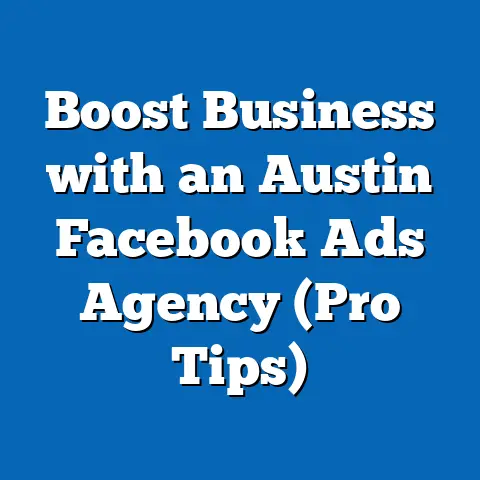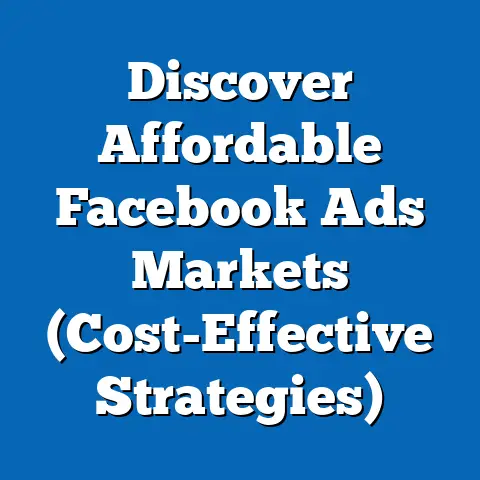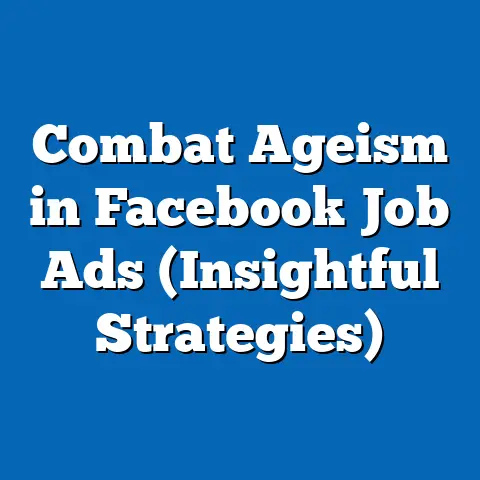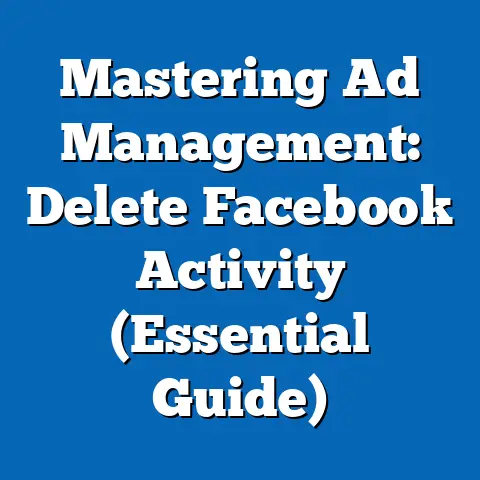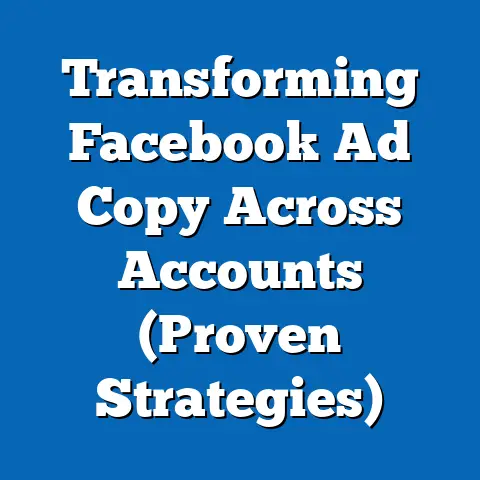Why Do Facebook Ads Slow Down? (Insights for Optimizing Performance)
Have you ever poured your heart and soul into crafting a Facebook ad campaign, only to watch its performance slowly dwindle over time? I know I have. It’s a frustrating experience that many digital marketers face. One day, your ads are generating leads and driving sales, and the next, they seem to be lost in the digital wilderness.
The truth is, Facebook advertising is a dynamic landscape. What works today might not work tomorrow. Understanding why your Facebook ads slow down is crucial for maintaining a successful advertising strategy. This isn’t just about throwing more money at the problem; it’s about understanding the underlying causes and implementing effective solutions.
In this guide, I’m going to walk you through the common reasons behind declining Facebook ad performance and provide actionable strategies for optimizing your campaigns. Whether you’re a seasoned marketer or just starting out, these insights will help you understand the Facebook ads ecosystem, identify the issues impacting your ads, and, most importantly, turn things around to drive better results for your business.
Section 1: Understanding the Facebook Ads Ecosystem
Before diving into the reasons for performance slowdowns, it’s essential to grasp the fundamentals of how Facebook Ads work. Think of Facebook’s advertising platform as a complex auction house. Every time a user visits Facebook or Instagram, an auction takes place in real-time to determine which ads they see.
The auction system considers several factors, including:
- Bidding Strategies: You set a bid, which is the maximum amount you’re willing to pay for a specific action (like a click or an impression). There are various bidding strategies you can choose, such as cost-per-click (CPC), cost-per-mille (CPM), or cost-per-action (CPA).
- Ad Placements: You can choose where your ads appear, such as in the Facebook News Feed, Instagram Feed, Audience Network, or Messenger. Each placement has its own characteristics and performance potential.
- Ad Quality: Facebook evaluates the quality and relevance of your ads based on factors like visual appeal, clarity of messaging, and alignment with the target audience’s interests.
How Facebook’s Algorithm Determines Ad Delivery
Facebook’s algorithm is the engine that drives ad delivery. It analyzes vast amounts of data to determine which ads are most likely to resonate with each user. The algorithm considers factors like:
- User Behavior: What pages has the user liked? What posts have they engaged with? What websites have they visited?
- Ad Relevance: How well does your ad match the user’s interests and demographics?
- Bid Amount: How much are you willing to pay to show your ad to this user?
- Ad Quality: How engaging and relevant is your ad?
The algorithm then assigns a “relevance score” to your ad. This score reflects how well your ad is expected to perform based on the factors above. A higher relevance score typically leads to lower costs and better ad delivery.
The Significance of Relevance Scores
Relevance scores are crucial for understanding why your ads may experience slowdowns. If your relevance score drops, it indicates that your ad is no longer resonating with your target audience. This can lead to:
- Decreased Visibility: Facebook may show your ad less frequently.
- Increased Costs: You may have to pay more to reach the same audience.
- Lower Engagement: Users may be less likely to click on or engage with your ad.
In essence, a low relevance score is a warning sign that your ad is losing its effectiveness. Monitoring your relevance scores and taking steps to improve them is essential for maintaining optimal ad performance.
Key Takeaway: Understanding the Facebook Ads ecosystem, including the auction system, algorithm, and relevance scores, is the foundation for diagnosing and addressing performance slowdowns.
Section 2: Common Reasons for Decreased Ad Performance
Now that we have a grasp of the Facebook Ads ecosystem, let’s dive into the common culprits behind decreased ad performance.
Ad Fatigue: The Silent Killer
Ad fatigue is one of the most common reasons why Facebook ads slow down. It occurs when your target audience has seen your ad too many times, leading to a decline in engagement and an increase in costs.
Think of it like this: imagine seeing the same TV commercial over and over again. Eventually, you’ll tune it out or even become annoyed by it. The same principle applies to Facebook ads.
Symptoms of Ad Fatigue:
- Declining Click-Through Rates (CTR): Fewer people are clicking on your ad.
- Increased Cost-Per-Click (CPC): You’re paying more for each click.
- Decreased Conversion Rates: Fewer people are taking the desired action after clicking on your ad (e.g., making a purchase, filling out a form).
- Negative Feedback: Users are hiding your ad or reporting it as irrelevant.
How to Combat Ad Fatigue:
- Refresh Your Creative: Regularly update your ad visuals, headlines, and copy.
- Rotate Your Ads: Use multiple ad variations and rotate them frequently.
- Refine Your Targeting: Ensure you’re targeting the right audience and exclude people who have already converted.
- Frequency Caps: Limit the number of times a user sees your ad.
Personal Story: I once ran a campaign for a local restaurant that was performing exceptionally well for the first few weeks. However, after about a month, I noticed a significant drop in engagement and a spike in costs. After analyzing the data, I realized that the audience was experiencing ad fatigue. I quickly refreshed the ad creative with new visuals and messaging, and the campaign performance immediately rebounded.
Target Audience Saturation: Reaching the Limit
Target audience saturation occurs when you’ve reached a significant portion of your target audience with your ads, and there are fewer new people to reach. This can lead to diminishing returns and increased costs.
Examples of Audience Overlap and Saturation:
- Small Target Audience: If you’re targeting a very specific niche with a limited audience size, you may quickly saturate the market.
- Overlapping Audiences: If you’re running multiple campaigns targeting similar audiences, you may be competing against yourself.
- High Frequency: If you’re showing your ads too frequently to the same people, you’ll eventually exhaust their interest.
How to Address Target Audience Saturation:
- Expand Your Targeting: Broaden your audience by including related interests or demographics.
- Create Lookalike Audiences: Use Facebook’s lookalike audience feature to find new people who are similar to your existing customers.
- Exclude Existing Customers: If your goal is to acquire new customers, exclude your existing customer base from your targeting.
- Layer Targeting Options: Combine multiple targeting options to create more specific and refined audiences.
Changes in Competition: The Crowded Marketplace
The Facebook advertising landscape is constantly evolving. As more businesses join the platform and compete for the same audience, ad costs can rise, and visibility can decrease.
How Increased Competition Affects Ad Performance:
- Rising Costs: More advertisers bidding on the same audience drives up the cost of ad impressions and clicks.
- Reduced Visibility: Your ads may be shown less frequently due to increased competition.
- Lower Click-Through Rates: Users may be bombarded with ads, making it harder to stand out.
How to Navigate Increased Competition:
- Refine Your Bidding Strategy: Consider using automated bidding strategies to optimize your bids in real-time.
- Improve Your Ad Quality: Create high-quality, engaging ads that capture attention and stand out from the crowd.
- Test Different Ad Formats: Experiment with different ad formats, such as video ads or carousel ads, to see what resonates best with your audience.
- Focus on Differentiation: Highlight what makes your business unique and why customers should choose you over the competition.
Ad Quality Issues: Meeting Facebook’s Standards
Facebook has strict guidelines for ad quality. Ads that are low-quality or violate Facebook’s policies can be penalized, leading to poor performance.
Common Pitfalls:
- Poor Visuals: Blurry, low-resolution images or videos.
- Unclear Messaging: Confusing or misleading ad copy.
- Misleading Claims: Making false or exaggerated claims about your products or services.
- Clickbait: Using sensational or misleading headlines to entice clicks.
- Policy Violations: Violating Facebook’s advertising policies, such as promoting prohibited products or services.
How to Ensure Ad Quality:
- Use High-Quality Visuals: Invest in professional-quality photos or videos.
- Write Clear and Concise Copy: Use clear, concise language that accurately describes your offer.
- Be Honest and Transparent: Avoid making misleading claims or using deceptive tactics.
- Review Facebook’s Advertising Policies: Familiarize yourself with Facebook’s advertising policies and ensure that your ads comply.
Key Takeaway: Ad fatigue, target audience saturation, increased competition, and ad quality issues are common reasons for decreased Facebook ad performance. Addressing these issues through creative refreshing, audience segmentation, bidding strategy refinement, and ad quality improvement is crucial for maintaining optimal results.
Section 3: Technical Factors Impacting Ad Performance
Beyond the creative and strategic aspects, several technical factors can also impact your Facebook ad performance.
Analytics and Tracking: The Foundation of Measurement
Proper analytics and tracking are essential for measuring the performance of your Facebook ads. Without accurate data, it’s impossible to identify issues and optimize your campaigns effectively.
Improper Tracking Setups:
- Pixel Issues: If your Facebook pixel isn’t installed correctly or is firing incorrectly, you won’t be able to accurately track conversions.
- Missing Event Tracking: If you’re not tracking important events, such as website visits, add-to-carts, or purchases, you’ll have limited insight into your customer journey.
- Attribution Issues: If you’re not using proper attribution settings, you may be misattributing conversions to the wrong ad campaigns.
How to Ensure Proper Tracking:
- Verify Pixel Installation: Use the Facebook Pixel Helper Chrome extension to verify that your pixel is installed correctly and firing on the correct pages.
- Set Up Event Tracking: Configure event tracking to track important user actions on your website.
- Use UTM Parameters: Add UTM parameters to your ad URLs to track traffic and conversions in Google Analytics.
- Review Attribution Settings: Review your attribution settings to ensure you’re accurately attributing conversions to the correct campaigns.
Ad Placement Issues: Choosing the Right Spot
Facebook offers a variety of ad placements, including the Facebook News Feed, Instagram Feed, Audience Network, and Messenger. Each placement has its own characteristics and performance potential.
Automatic Placements vs. Manual Placements:
- Automatic Placements: Facebook automatically places your ads on the placements where they’re most likely to perform well.
- Manual Placements: You manually choose the placements where you want your ads to appear.
When to Use Each Strategy:
- Automatic Placements: Ideal for beginners or when you want to maximize reach and let Facebook optimize ad delivery.
- Manual Placements: Ideal when you have specific placement preferences or want to control where your ads appear.
How to Optimize Ad Placements:
- Test Different Placements: Experiment with different placements to see which ones perform best for your target audience.
- Customize Ad Creative: Tailor your ad creative to fit the specific requirements of each placement.
- Monitor Placement Performance: Regularly monitor the performance of each placement and adjust your strategy accordingly.
Seasonal Trends: Riding the Wave
Seasonal trends can significantly impact Facebook ad performance. Consumer behavior and demand fluctuate throughout the year, so it’s essential to adapt your strategies accordingly.
Examples of Seasonal Trends:
- Holiday Shopping: During the holiday season, competition for ad space increases, and costs can rise.
- Back-to-School: During the back-to-school season, parents are more likely to purchase school supplies and clothing.
- Summer Travel: During the summer months, people are more likely to book vacations and travel experiences.
How to Adapt to Seasonal Trends:
- Plan Ahead: Start planning your seasonal campaigns well in advance.
- Adjust Your Budget: Increase your budget during peak seasons to capture increased demand.
- Tailor Your Messaging: Customize your ad messaging to align with the seasonal theme.
- Target Relevant Interests: Target users who are interested in seasonal activities or products.
Key Takeaway: Technical factors like analytics and tracking, ad placement issues, and seasonal trends can significantly impact Facebook ad performance. Ensuring proper tracking setups, optimizing ad placements, and adapting to seasonal trends are crucial for maintaining optimal results.
Section 4: Strategies for Optimizing Facebook Ad Performance
Now that we’ve identified the common reasons for Facebook ad slowdowns, let’s explore strategies for optimizing your campaigns and improving performance.
Refreshing Creative: Keeping It Fresh
As we discussed earlier, ad fatigue is a major cause of performance decline. Refreshing your ad creative is one of the most effective ways to combat ad fatigue and re-engage your target audience.
Actionable Tips:
- Change Visuals: Use new photos, videos, or graphics.
- Update Headlines and Copy: Revise your headlines and ad copy to create a sense of novelty.
- Test Different Formats: Experiment with different ad formats, such as video ads, carousel ads, or collection ads.
- Highlight New Offers: Promote new products, services, or discounts.
Examples:
- Before: An ad for a clothing store featuring a static image of a model wearing a dress.
- After: A video ad showcasing a variety of outfits from the same store, with models of different body types and ethnicities.
Audience Segmentation: Targeting the Right People
Segmenting your audience is another powerful strategy for optimizing Facebook ad performance. By dividing your audience into smaller, more targeted groups, you can create ads that are more relevant and engaging.
Effective Segmentation Strategies:
- Demographics: Age, gender, location, education, income.
- Interests: Hobbies, passions, activities.
- Behaviors: Purchase history, website activity, Facebook engagement.
- Custom Audiences: People who have interacted with your website, app, or Facebook page.
- Lookalike Audiences: People who are similar to your existing customers.
Example:
- Instead of running a single ad campaign targeting all women aged 25-45, segment your audience into smaller groups based on their interests, such as “yoga enthusiasts,” “fashion lovers,” or “foodies.”
Continuous Testing and Optimization: The Never-Ending Journey
A/B testing, also known as split testing, is a crucial part of optimizing ad performance. It involves testing different versions of your ads to see which ones perform best.
Best Practices for Testing:
- Test One Element at a Time: To accurately measure the impact of each change, test only one element at a time, such as the headline, visual, or call-to-action.
- Use a Control Group: Create a control group that doesn’t see any of your ads so you can accurately measure the lift generated by your campaigns.
- Run Tests for a Sufficient Period: Allow your tests to run for a sufficient period to gather statistically significant data.
- Analyze Results and Iterate: Analyze the results of your tests and use the insights to optimize your campaigns.
Monitoring and Adjusting Budgets: Staying on Track
Regularly monitoring your ad performance metrics and adjusting your budgets based on the data is essential for maximizing ROI.
Guidance on Monitoring:
- Track Key Metrics: Monitor metrics such as impressions, clicks, CTR, CPC, conversions, and ROI.
- Set Performance Benchmarks: Establish performance benchmarks for each campaign and track your progress against those benchmarks.
- Use Reporting Tools: Utilize Facebook Ads Manager’s reporting tools to track your performance and identify areas for improvement.
Key Takeaway: Refreshing creative, segmenting audiences, continuous testing and optimization, and monitoring and adjusting budgets are essential strategies for optimizing Facebook ad performance. Implementing these strategies will help you combat ad fatigue, improve ad relevance, and maximize your ROI.
Conclusion
Facebook advertising is a powerful tool for reaching your target audience and driving business results. However, it’s not a “set it and forget it” endeavor. As I’ve experienced firsthand, ad performance can fluctuate over time, and it’s crucial to understand the reasons behind those fluctuations.
By understanding the Facebook Ads ecosystem, identifying common reasons for performance slowdowns, and implementing effective optimization strategies, you can take control of your campaigns and achieve better results.
Remember, the key is to be proactive, data-driven, and adaptable. Regularly monitor your ad performance metrics, test new strategies, and adjust your approach as needed. With diligent monitoring and adjustment, you can overcome the challenges of Facebook advertising and unlock the full potential of the platform.
So, take the insights I’ve shared today and apply them to your Facebook ad campaigns. Don’t be discouraged by slowdowns; view them as opportunities to learn, adapt, and improve. With the right strategies and a commitment to continuous optimization, you can achieve sustainable success with Facebook advertising.
If you’ve found this guide helpful, I encourage you to share your experiences with Facebook ads in the comments below. What challenges have you faced, and what strategies have worked best for you? Let’s learn from each other and help each other succeed in the ever-evolving world of Facebook advertising. Together, we can navigate the complexities of the platform and achieve our marketing goals.


